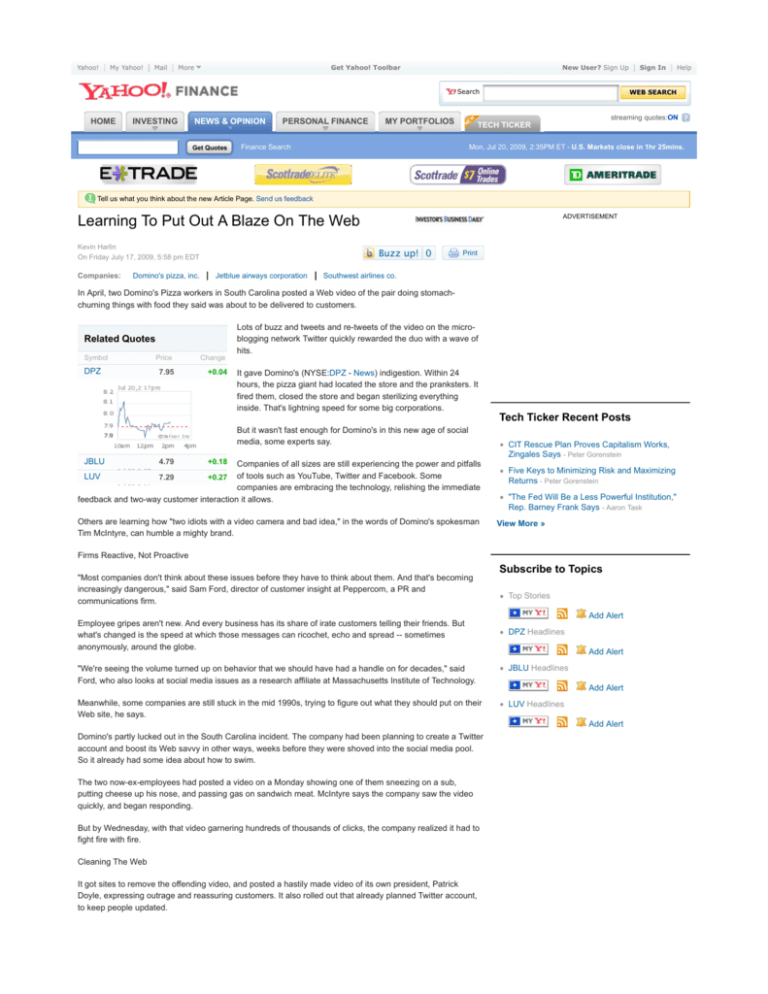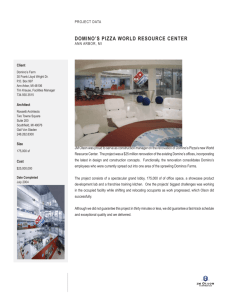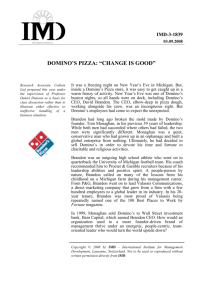Learning To Put Out A Blaze On The Web
advertisement

Yahoo! My Yahoo! Mail More Get Yahoo! Toolbar New User? Sign Up Search HOME INVESTING NEWS & OPINION Get Quotes PERSONAL FINANCE MY PORTFOLIOS streaming quotes:ON Mon, Jul 20, 2009, 2:35PM ET - U.S. Markets close in 1hr 25mins. Tell us what you think about the new Article Page. Send us feedback Learning To Put Out A Blaze On The Web Kevin Harlin On Friday July 17, 2009, 5:58 pm EDT Companies: Domino's pizza, inc. ADVERTISEMENT Buzz up! 0 Jetblue airways corporation Print Southwest airlines co. In April, two Domino's Pizza workers in South Carolina posted a Web video of the pair doing stomachchurning things with food they said was about to be delivered to customers. Related Quotes Symbol DPZ Price Change 7.95 +0.04 Lots of buzz and tweets and re-tweets of the video on the microblogging network Twitter quickly rewarded the duo with a wave of hits. It gave Domino's (NYSE:DPZ - News) indigestion. Within 24 hours, the pizza giant had located the store and the pranksters. It fired them, closed the store and began sterilizing everything inside. That's lightning speed for some big corporations. But it wasn't fast enough for Domino's in this new age of social media, some experts say. JBLU 4.79 +0.18 LUV 7.29 +0.27 Help WEB SEARCH TECH TICKER Finance Search Sign In Companies of all sizes are still experiencing the power and pitfalls of tools such as YouTube, Twitter and Facebook. Some companies are embracing the technology, relishing the immediate feedback and two-way customer interaction it allows. Others are learning how "two idiots with a video camera and bad idea," in the words of Domino's spokesman Tim McIntyre, can humble a mighty brand. Tech Ticker Recent Posts CIT Rescue Plan Proves Capitalism Works, Zingales Says - Peter Gorenstein Five Keys to Minimizing Risk and Maximizing Returns - Peter Gorenstein "The Fed Will Be a Less Powerful Institution," Rep. Barney Frank Says - Aaron Task View More » Firms Reactive, Not Proactive "Most companies don't think about these issues before they have to think about them. And that's becoming increasingly dangerous," said Sam Ford, director of customer insight at Peppercom, a PR and communications firm. Employee gripes aren't new. And every business has its share of irate customers telling their friends. But what's changed is the speed at which those messages can ricochet, echo and spread -- sometimes anonymously, around the globe. Subscribe to Topics Top Stories Add Alert DPZ Headlines Add Alert "We're seeing the volume turned up on behavior that we should have had a handle on for decades," said Ford, who also looks at social media issues as a research affiliate at Massachusetts Institute of Technology. JBLU Headlines Meanwhile, some companies are still stuck in the mid 1990s, trying to figure out what they should put on their Web site, he says. LUV Headlines Add Alert Add Alert Domino's partly lucked out in the South Carolina incident. The company had been planning to create a Twitter account and boost its Web savvy in other ways, weeks before they were shoved into the social media pool. So it already had some idea about how to swim. The two now-ex-employees had posted a video on a Monday showing one of them sneezing on a sub, putting cheese up his nose, and passing gas on sandwich meat. McIntyre says the company saw the video quickly, and began responding. But by Wednesday, with that video garnering hundreds of thousands of clicks, the company realized it had to fight fire with fire. Cleaning The Web It got sites to remove the offending video, and posted a hastily made video of its own president, Patrick Doyle, expressing outrage and reassuring customers. It also rolled out that already planned Twitter account, to keep people updated. By the end of that week, the online chatter had changed from discussions of the disgusting acts -- to talk about how Domino's was responding. It died down almost completely shortly after that. Despite what was seen as an initial stumble, communications specialists gave Domino's mostly high marks for its overall performance. JetBlue Airways (NasdaqGS:JBLU - News) is another company that knows how to handle challenges on the Web, Ford says. He recounted the story of a colleague at Peppercom, stranded at the boarding gate of a delayed JetBlue flight out of Orlando. After several hours with little news, he sent a Twitter message to the airline at 10:30 p.m. Twenty minutes later, a representative Tweeted back, explaining the cause of the delay, promising to make sure 200-or-so other stranded customers knew what was happening. The gate agents followed up moments later with an updated announcement. Its rival Southwest Airlines (NYSE:LUV - News) also gets plaudits from its social media presence. Its blog, "Nuts About Southwest," has been up for three years. It also posts fresh content and has loyal followers on a host of sites such as Flickr, Facebook, LinkedIn, and others. All this is encouraging. But it's not the norm yet for companies, says Lon Safko, a technology consultant and co-author of "The Social Media Bible: Tactics, Tools and Strategies for Business Success." "If you look at the C-suite, those people haven't a clue of what social media is and how to use it because they didn't grow up with it," he said. "They're trying to set policy, but honestly, they aren't qualified." One common criticism is the opened, then nearly abandoned Twitter account, or Facebook or MySpace page. Some companies who don't know what to say, say nothing. Equally bad is using social media sites as conduits to deluge followers with press releases and minor corporate minutiae. Safko suggests companies need to train employees on how to stay on message and avoid giving away trade secrets. And publicly traded companies could run afoul of Securities and Exchange Commission rules if an insider says too much. Some execs wonder if sites like Twitter are merely a fad. And immensely popular Facebook may not be the final evolution of the social media genre. That's OK, says Ford. Sites will come and go. "We have to separate the players from the game itself," he said. "You're not investing in Facebook. You're investing in a relationship and a rapport with your customers." And most experts say it's surprisingly easy to get started. Just start listening to what people are saying. Domino's created a new position: "social media specialist." It put a Web-savvy guy in his early 30s in the job, McIntyre says. Safko says it's surprising how many companies haven't programmed monitoring sites to instantly alert them to mentions of their products, brands or companies. And of course, there's a dark side to the force. Kmart generated some buzz, and some heat, last year when it offered $500 gift cards to a handful of bloggers willing to shop at the discount chain and write about their experiences. At least some of the posts were labeled as sponsored content. But if those bloggers' readers didn't notice, other bloggers, and Twitter users did their best to publicize the fact. Safko says that self-policing aspect adds to the medium's credibility. "You try to oversell yourself and make a sales pitch, and you're going to get flamed," he said. "They're going to put you in your spot." In the end, experts say social media is about open dialogue and being transparent. Customers feel ownership of the brands they care about. Sometimes they will praise them. Or, they'll trash-talk them mercilessly. The online tools can amplify both messages. Domino's McIntyre knows that. "We look at the things that are out there, we look at what people say, and we realize that everybody has an opinion," he said. "And thank goodness we can express our opinions too."










